Do You Have 19 for 19?

by Mary Ellen Daneels, Lead Teacher Mentor While the last remaining days of 2018 are slipping away and many of us are looking forward to a well-deserved holiday break — the end of the year also marks a time of new beginnings. The new year brings with it a fresh start and resolutions for improvement both in and out of the classroom. One of my favorite non-civics-related podcasts is “ Happier ”, hosted by bestselling author Gretchen Rubin and her sister, T.V. writer Elizabeth Craft . I find the podcast gives me practical tips to embrace habits that help me be, well, “happier” in both work and play. On their most recent podcast , they reflected on their resolutions for 2018 and started creating their “19 for 19” — a list of 19 items they would like to complete upcoming year. As you contemplate the new year, what is on your list? Are there new strategies related to the proven practices of civic education you would like to try? Is there a new lesson plan you would like to e...















